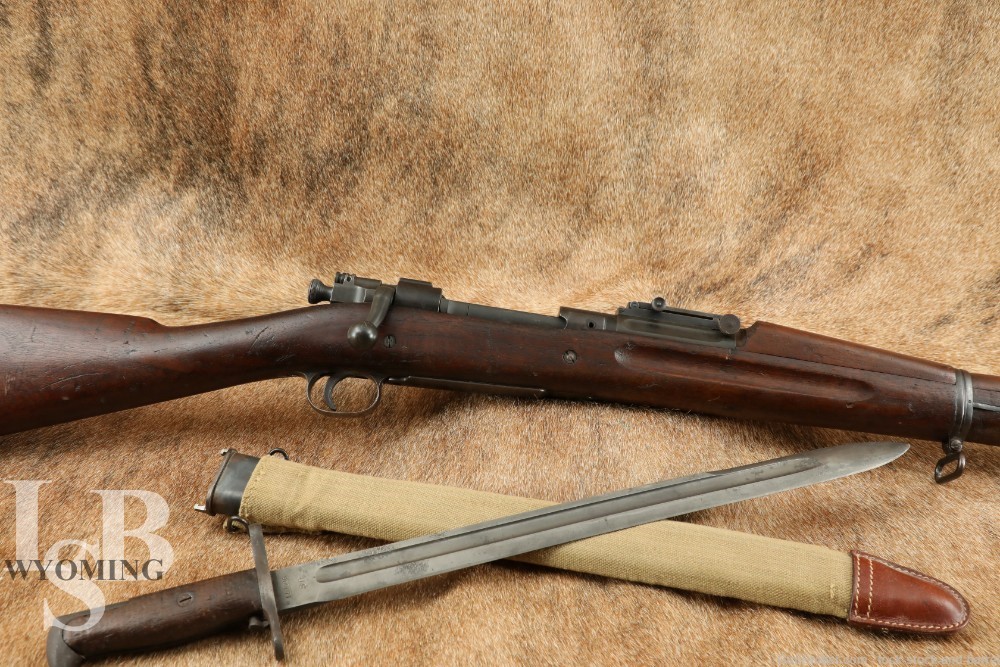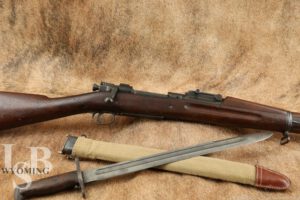
US Springfield M1903 Mk. 1 Pedersen Cut .30-06 Rifle & Bayonet, 1920 C&R
SOLD FOR: $1,375.00
LSB#: WY240905SP062
Make: Springfield Armory
Model: 1920
Serial Number: 1172789
Year of Manufacture: 1920 (https://www.nps.gov/spar/learn/historyculture/u-s-springfield-model-1903-production.htm)
Barrel Date: March, 1920
Caliber: .30-06 Springfield
Action Type: Bolt Action, 5 Round Internal Magazine
Markings: The top of the receiver is marked “U.S. / SPRINGFIELD / ARMORY / MODEL 1903 MARK I / 1172789”. The top of the barrel is marked “S A / flaming bomb / 3 – 20” . The safety is marked “SAFE READY” and the magazine cutoff is marked “ON OFF”. There are various small letter proofs throughout. The stock is marked, with an “E.H.” (E. Hancock) inspection mark and triple rebuild marks that appear to be Augusta Arsenal, Raritan Arsenal, and possibly Hawaiian Ordnance Depot. The bayonet is marked, “S A 1980 / US 969071 / 866”.
Barrel Length: Approximately 24 Inches
Sights / Optics: The front sight is a pinned blade atop a raised base. The rear sight is an adjustable flip-up V-notch ladder sight marked out to 27.
Stock Configuration & Condition: The stock is a two piece wood set with a capped forend/bayonet lug & stacking ring, barrel band w/ sling loop, two through bolts, semi-pistol grip, straight comb, sling loop, and steel buttplate. There are scratches, pressure dents and small chips. There are no cracks. The LOP measures 12 3/4 inches from the front of the trigger to the back of the buttplate. The stock rates in about Good overall condition.
Type of Finish: Parkerized, Blued
Finish Originality: Original Arsenal rebuild.
Bore Condition: The bore is semi-bright, the rifling is moderately worn. There is moderate to erosion and no pitting in the bore. In this writer’s opinion, the bore rates at a 6/10.
Overall Condition: This rifle retains about 75% of its metal finish. There are scratches, nicks, and light patina throughout. The bottom metal has spots of rust. The buttplate has light impact marks. The action has light wear. The screw heads are lightly tooled. The markings are well defined. Overall, this rifle rates in about Very Good condition. The M1905 bayonet is in Good shape. The scabbard cover is loose, the blade has cleaned out pitting.
Mechanics: The action functions correctly. We did not fire this rifle. As with all used firearms, a thorough cleaning may be necessary to meet your maintenance requirements.
Box, Paperwork & Accessories: M1905 Bayonet.
Our Assessment: The U.S. Springfield M1903 Mk. 1 Pedersen Cut in .30-06 is a bolt-action rifle that holds a unique place in firearm history due to its innovative design and its intended role as part of a secret U.S. Army project during World War I. Manufactured by the Springfield Armory, the Mk. 1 variant was modified to accommodate the Pedersen Device, a groundbreaking accessory that transformed the rifle into a semi-automatic firearm. Although the device was never used in combat, the Mk. 1 remains a fascinating artifact of military ingenuity. The M1903 Mk. 1 is chambered in .30-06 Springfield, a cartridge renowned for its long-range accuracy, flat trajectory, and versatility. In its standard configuration, the rifle performed admirably as a bolt-action weapon, making it a staple of the U.S. military during the early 20th century. The defining feature of the Mk. 1 is the “Pedersen Cut,” a modification to the left side of the receiver. This cut allowed for the attachment of the Pedersen Device, an accessory designed to replace the standard bolt with a mechanism that converted the rifle into a semi-automatic firearm. The device utilized special .30-caliber pistol-style cartridges, stored in a 40-round magazine that extended from the rifle’s top. The concept was to provide infantry with a rapid-fire weapon for trench warfare, bridging the gap between bolt-action rifles and fully automatic weapons. The Mk. 1 retained the core characteristics of the Mauser-inspired M1903 bolt-action mechanism, including a strong receiver and a five-round internal magazine for use with standard .30-06 cartridges. The Pedersen Device could be installed and removed without permanent alteration to the rifle, allowing it to revert to its original configuration. The rifle features a 24-inch barrel, providing excellent accuracy and ballistic performance. It also retained the full-length wooden stock typical of the M1903 series, offering durability and protection for the barrel. For aiming, the Mk. 1 is equipped with a rear sight adjustable for elevation and windage and a fixed blade front sight, allowing precise shooting with .30-06 ammunition. The Pedersen Device was conceived as a response to the static, close-quarters combat of World War I trenches. By enabling soldiers to deliver rapid fire, the device aimed to increase firepower during assaults. Despite its innovative design, the war ended before the device could be deployed. Over 100,000 Pedersen Devices were manufactured, but they were later destroyed due to obsolescence and the advent of new weaponry, such as the M1 Garand. This particular rifle comes with a Springfield Armory produced M1905 bayonet with a canvas scabbard. While the bayonet has seen better days, it has been cleaned up nicely and is good condition for its age.
Overall, the M1903 Mk. 1 rifles, distinguished by their Pedersen Cut, were produced in relatively limited quantities. Without the Pedersen Device, they functioned as standard M1903 rifles, serving in various roles during the interwar period and into World War II. Today, these rifles are highly sought after by collectors due to their historical connection to one of the U.S. military’s most ambitious but unrealized projects. -R.E.

